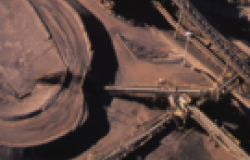Getting more out of EITI data: Incorporating Data Standardisation into EITI reporting

This post represents the fifth in a series of opinion pieces from the ongoing 2016 EITI Conference, in Lima, Peru being covered on the ground by the Global Leadership Initiative's team. Please check in regularly to keep up to date with the latest news and analysis from the summit. For previous posts please click here.
EITI reports have made great progress in making the plethora of tax and royalty systems that govern the extractives sector accessible. However, as the initiative has grown in size and significance, it has become increasingly difficult to visualise the vast amounts of data to draw parallels across different countries. Standardised data reporting will enable effective cross-country and year on year comparisons. These comparisons will provide a framework to optimise natural resource governance on a country specific basis by drawing on governance experiences in peer nations.
In seven years, almost 300 publications of EITI reports have yielded huge volumes of data from extractive sector stakeholders. The need to make data work harder to deliver development at the 2016 global conference in Lima is encapsulated in the conference headline ‘From Reports to Results’. At present individual country commissions implement the standard and these commissions choose a number of different parameters for their report. The parameters include which revenues to publish and what degree of market coverage of extractive companies to collect data from. The material payments reporting threshold varies considerably.
Why Standardise Data in EITI Reporting?
Some countries such as Peru and Norway publish only direct revenues, whilst others like Mongolia publish both direct and indirect revenues. These differences in methodologies are not usually made explicit within reports. The EITI also currently offers no guideline for data reporting to countries, which limits the usefulness of the data for cross-country comparisons. The standardisation of EITI data will enable the identification of so-called peer countries, who have similarities in their institutional strength and geological natures but often very different systems of natural resource taxation, through cross country comparison.
Comparisons of extractive governance between peer countries, gathered from a simple discount model along the lines of the IMFs FARI model can provide interesting insights into the effectiveness of different regimes.
As proposed at the EITI conference this template can be shared amongst peer countries using the same set of assumptions. This provides invaluable access to revenue forecasting information for institutions that cannot develop their own forecasts of natural resource revenue.
Governments are not always able to develop sophisticated revenue forecasts due to a lack of information and a lack of resources to dedicate to modelling. Cross country comparisons can help to tackle both of these problems: By identifying substitute sources to use in situations where country specific data is unavailable and providing scenarios for open source modelling projects.
For example, OpenOil analysis suggests that there are now in excess of 1000 modellable extractives projects, which can provide a basis for peer country assumptions and plug so called 'data black holes'. Enabling governments to model future revenues from extractives will facilitate good governance and extractives legislative reform whilst addressing the perceived information asymmetry between industry and government.
The EITI was instrumental in the extractives transparency revolution and through data standardisation can now be used to make assessments on a country specific 'fair deal'. Cross-country comparison can provide some guidance on the revenue a country could receive from natural resources based on the experiences of its peers. Additional sensitivities can be then run to show the impact on government revenue of different commodity price scenarios.
Standardising EITI reporting is the essential first step in allowing analysts to identify peer countries and engage in meaningful cross-country comparison.
How can Standardisation be achieved?
The EITI and the IMF have worked together to agree a framework that improves consistency in EITI data. This framework is now being trialled in six EITI compliant countries to assess its advantages and limitations. Furthermore, it uses the IMF's internationally recognised Government Finance Statistics Manual (2014) to classify revenue from extractives into four universal categories: rent, taxation, social contributions and grants.
A one off exposé of extractives governance on a country by country basis enables a comparison of different natural resource governance regimes using the simplified revenue stream classifications. For ease of implementation the standard uses existing EITI data categories and requires a one off categorisation process by each MSG.
In December 2015 the EITI set up a technical working group to develop data standards to submit to the EITI board. It is to be hoped that the board accepts a raft of greater data standardisation methods which will provide a framework to make EITI data work harder and to maintain the initiative's relevance through enabling effective cross-country comparisons. These expansions to EITI reporting will allow the initiative to work harmoniously with other international data collectors including Eurostat, IMF and the World Bank as well as creating greater accessibility to meaningful information to broaden the EITI's appeal.
The framework complements a reporting strategy proposal showcased by the World Bank at the 2016 conference which adopts a better approach to EITI reporting. In order to enable more accessible cross-country comparisons, it is imperative that the EITI continues to push for higher standards in data collection and reporting to cement its position as the gold standard in international extractive sector data.
Eleanor Horn is a Policy Analyst of the Global Learning Initiative (GLI). She is currently undertaking BSc Economics at the University of Sheffield, UK.


